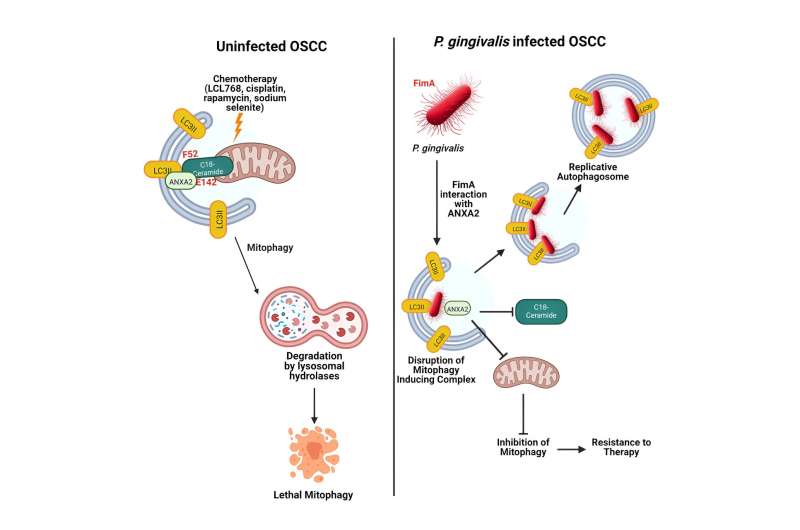This article has been reviewed according to Science X's editorial process and policies. Editors have highlighted the following attributes while ensuring the content's credibility:
fact-checked
peer-reviewed publication
trusted source
proofread
Interdisciplinary team maps role of P. gingivalis in drug resistance

A new paper from an interdisciplinary team at MUSC Hollings Cancer Center describes how the bacteria Porphyromonas gingivalis interferes with chemotherapy-induced mitophagy, allowing oral cancer tumors to become resistant to the drug's effects.
Besim Ogretmen, Ph.D., SmartState Endowed Chair in Lipidomics and Drug Discovery in the College of Medicine, and Ӧzlem Yilmaz, D.D.S., Ph.D., a professor, clinician-scientist and microbiologist in the College of Dental Medicine, worked with graduate student Megan Sheridan and other Hollings researchers to uncover how P. gingivalis promotes chemotherapy resistance.
Their paper was published in iScience.
P. gingivalis is a bacterium found in the mouth. In a healthy mouth, P. gingivalis and other disease-causing bacteria are kept in check by beneficial bacteria. But when that balance is disrupted, P. gingivalis is a major contributor to periodontitis—severe gum disease that can destroy gums and the bones holding the teeth in place. P. gingivalis can enter and survive inside the first lining cells of mucosa in the mouth, and then the microorganism can invade deeper tissue and spread systemically. Increasingly, it is being implicated in other diseases like Alzheimer's, diabetes and gastrointestinal cancers.
It's also been observed that oral cancer patients infected with P. gingivalis have worse outcomes. This paper maps out how that could be occurring, focusing on how intracellular P. gingivalis prevents ceramide-dependent mitophagy in oral squamous cell carcinomas.
Mitophagy, a specific form of autophagy, is the removal of damaged mitochondria. Ceramide is a sphingolipid that plays a key role in starting the process of lethal mitophagy.
"We understood that P. gingivalis is interfering with the lethal autophagy, making the cells not go to cell death—which is something you do not want," Yilmaz said. "We needed to understand which part of the bacterium is interacting with those host molecules to create this resistance, or this protection against lethal mitophagy."
After a few dead ends, the team homed in on the fimbriae—protruding pili-like protein structures on the outside of the bacteria. Whereas pili's function is sensing or synchronized movement to move fluids or objects, the fimbriae's major role is to attach.
"This molecule has been studied in this bacterium in a variety of contexts, like attaching to other bacteria, attaching to the collagen, attaching to fibrinogen. But it's not like it's just attaching to anything. It's a very specific event," Yilmaz said.
Ogretmen, whose lab focuses on the regulation and function of bioactive sphingolipids, figured out where the interaction was occurring, while Yuri Peterson, Ph.D., a Hollings researcher in the College of Pharmacy, used prediction analysis to identify the strong interactions between the bundles of peptides and the ceramide drug, Yilmaz said. But it was Yilmaz who first suggested they look at the fimbriae.
"Because we didn't know how this microorganism inhibited this chemotherapy effect. We tried many different things. Then [Yilmaz] said, 'Maybe you should try this protein.' We looked, and that was it," Ogretmen said
The team's work suggests that the fimbriae attach themselves to specific proteins on the mitophagic membrane, blocking the ceramide drug from its attachment point and therefore stopping the lethal mitophagy in its tracks.
"So then the next goal is, 'Can we use antibiotics to inhibit the protrusion protein so that it cannot interfere?'" Ogretmen said.
A visiting summer student will start work on this question, he said.
Yilmaz noted that another question is how the variations in fimbriae affect their interference with mitophagy. There are many strains of P. gingivalis, and different strains may have modifications in the fimbriae structure that can affect its interactions with host target molecules.
Yilmaz said this research was possible only because of the individual expertise of each of the investigators in vastly different fields.
"It was a true collaboration," Ogretmen agreed. "And we complement each other's expertise."
More information: Megan Sheridan et al, Opportunistic pathogen Porphyromonas gingivalis targets the LC3B-ceramide complex and mediates lethal mitophagy resistance in oral tumors, iScience (2024). DOI: 10.1016/j.isci.2024.109860

















